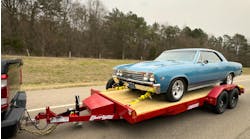Columbus, In. A solid economy will continue to drive commercial vehicle equipment sales at high levels through next year, and the outlook into the 2020s is guardedly optimistic, according to presentations by economists, market analysts, equipment manufacturers and other industry insiders at ACT Research’s annual summer gathering. Seminar #59 was held here August 20-22.
“We are in a unique time right now,” said Brett Olsen, marketing manager for Utility Trailer Manufacturing Company. “The economy is really strong. We’re at levels we’ve never seen before in my 32 years of building trailers.”
He recalled the excitement when, in his first year with the company, Utility built a “landmark” 5,000 trailers. The company is targeting about 50,000 trailers this year, Olsen noted.
“Is this sustainable? We don’t know, but a lot of the worry and angst about the election of President Trump has gone out of the market. We’ve got the tax break; the consumer has confidence and he’s spending money—all this generates freight. And freight is what it’s all about. When fleets have freight, they make money; and when truckers have money, they buy equipment.”
Of the challenges facing trailer manufacturers, Olsen points to supplier capacity constraints, increased material and labor costs, and rising interest rates.
“On the components we share with a truck—tires, suspensions, brakes, wheels—when truck sales really take off, the trailer guys get a little nervous because all the resources start going to the big truck guys,” Olsen said.
As for material pricing, Olsen noted that manufacturers had yet to feel the full impact of the Trump administration’s tariff increases, but that industry suppliers are “uneasy” and that unease has pushed prices higher in anticipation. Earlier this year the president announced plans for a 25% tariff on steel and a 10% tariff on aluminum imports, the opening volley in a developing international trade war.
“They don’t know exactly how the tariffs are going to affect them, and how they should react,” Olsen said. “Consequently, they’ve been hesitant to give us pricing. Right now, we have demand in the trailer market to sell well into the second quarter of 2019. We could probably push our backlog into the third quarter—but what we don’t have is confidence in our suppliers that they will be able to give us the pricing that’s going to make sense. Because of the tariffs, they just don’t know.”
Olsen referred specifically to the cost of aluminum, and recent volatility that saw prices climb above $2,000 per metric ton in the second half of 2014 before falling below $1,500 in 2015 and climbing again to $2,300 early this summer. He noted that a Utility refrigerated trailer contains 5,000 pounds of aluminum.
“When aluminum is volatile like that, and you don’t know where it’s going to land and you can’t count on your extruders and your rollers and everybody else to give you a price that you can live with into the quarters where the demand is, it puts a lot of pressure on you,” he said. “We’re not quite as bullish as we might be because we don’t know where this is going to end.”
But Frank Maly, ACT’s director of CV Transportation Analysis and Research, was willing to provide the firm’s best guesses. Coming on the heels of the strongest July for trailer orders in history (which equates to an adjusted annual rate of more than 500,000 units), ACT projects US trailer production to hit a record 321,000 units this year and to remain above 300,000 units in 2019. Based on a middle-of-the-road economic forecast, trailer production will moderate somewhat but still remain above 260,000 units through 2023.
“Fleet capacity challenges and the opportunities to haul more freight with solid freight rates—of course people are going to want equipment,” Maly said, pointing to data indicating soaring spot and contract rates for truckers. “This is driving some phenomenal bottom lines.”
Of the recent activity, Maly emphasized the importance of a low cancellation rate, running at 0.7% for the previous nine months.
“The orders that are going on the order board are staying on the order board,” Maly said. “Fleets know it’s a long line. If they’re in the order board they better stay there, because if they get out it’s ‘see you in April.’”
But as Utility’s Olsen mentioned, the booming market brings its own set of challenges to trailer manufacturers. Maly pointed to a surge of “red tags,” or units pulled from the production line because parts or materials weren’t available to complete the build. Trailers in this “limbo” can skew the monthly production reports because they are counted only when completed, even though they were largely built the month before.
Nonetheless, times are good.
“We’re sitting here in the best market in history, and it’s highly van driven—supported by reefers, supported by flatbed,” Maly said.
On the truck side, ACT President and Senior Analyst Kenny Vieth pointed to many of the same factors in explaining record Class 8 truck production and a strong forecast. On the plus side, the economy “is doing pretty darn well,” and it’s a good time to be a trucker. Areas of concern include rising inflation and interest rates, and tariffs and trade tensions.
Vieth strongly disagreed with recent comments by President Trump who said that trade wars are “good and easy to win,” and explained that the administration’s unpredictable policy making complicates the job of a market forecaster.
“Which Donald Trump is running trade? Is this just words and bluster, or is this going to translate into actions,” Vieth said. “Certainly the answer to this question gives a meaningfully different economic forecast as we look into the second half of 2019 and into 2020.”
A recent study projects that about 30,000 new jobs would be created because of the tariff program—but about 433,000 jobs would be lost, Vieth noted.
Still, barring an unanticipated shock to the broader economy, Vieth’s heavy-duty truck outlook is hopeful. For 2019, carriers remain well-positioned for continued robust profitability, and ACT bumps North American Class 8 production 5% or so ahead of this year’s projected 316,000 units. Demand might even justify a higher total, if manufacturers can maintain a higher production rate, Vieth noted.
Moving into 2020, ACT projects a slowing economy and falling freight and rates—and a corresponding dip in Class 8 production—before a modest market recovery in 2021-2022. Looking ahead five years, ACT anticipates truck production in 2023 will get a boost from an anticipated pre-buy ahead of stricter GHG standards that will challenge truck manufacturers—and result in more complex, more expensive equipment.
On the medium-duty side, ACT Vice President Steve Tam said it’s “business as usual,” even as orders recently have picked up 23% year-to-date in Classes 5 to 7, but that should moderate seasonally through the remainder of the year.
“We have seen, ever since the Great Recession, very moderate sustainable growth and that’s what our forecast is,” he said.
But the medium-duty market also is subject to many of the capacity constraints challenging Class 8 and trailer production, leading to some delivery delays.
More broadly, these smaller commercial vehicles are claiming more of the market as Class 8’s share falls.
ACT projects slight increases in North American production for Classes 4-7 in 2019 and 2020, up from this year’s projected 260,000 to 265,000 units, with a small dip in 2021 before climbing again through 2023.
ACT’s Seminar #60 is scheduled for March 25-27, 2019.













